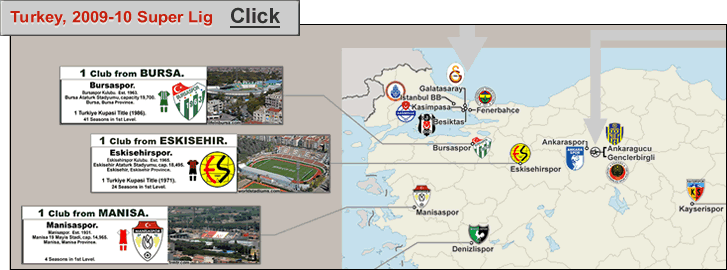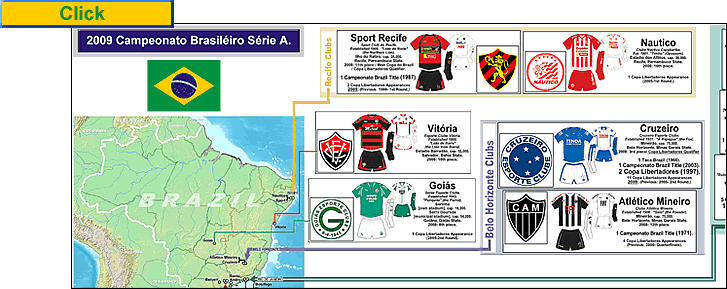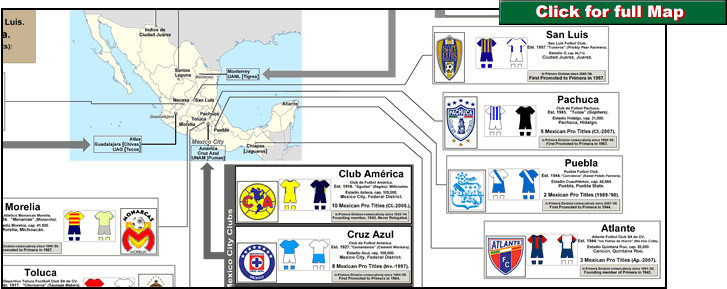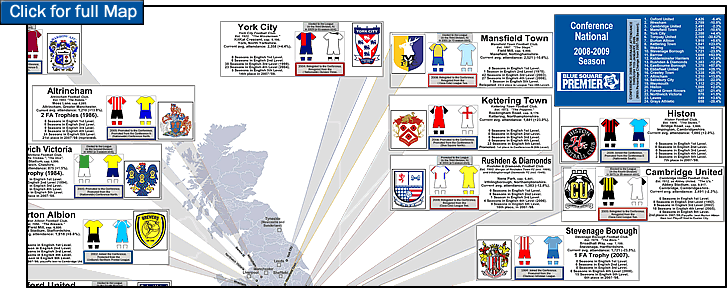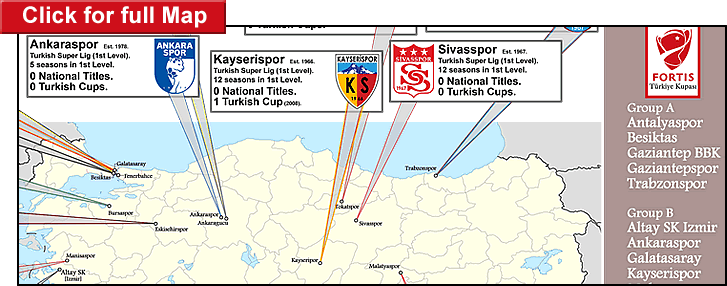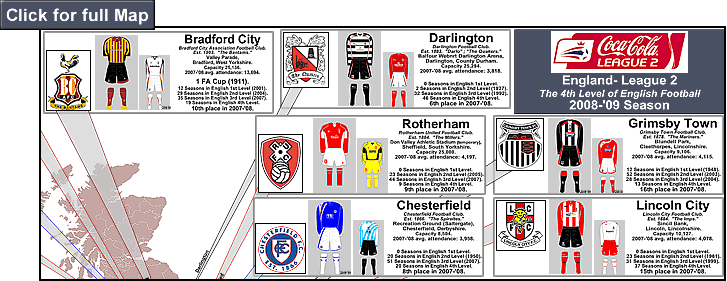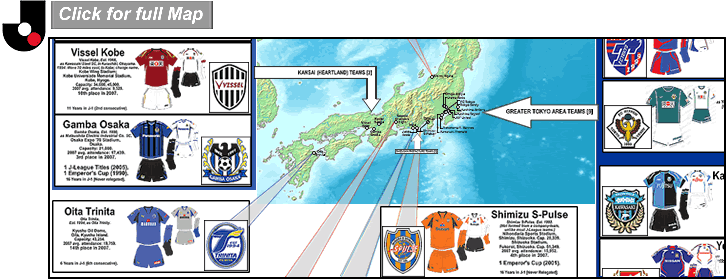Please note: to see my most-recent post on Mexican football (from January 2017), click on the following, category: Mexico/fútbol.
.
.
.
.
.
.
.
.
.
.
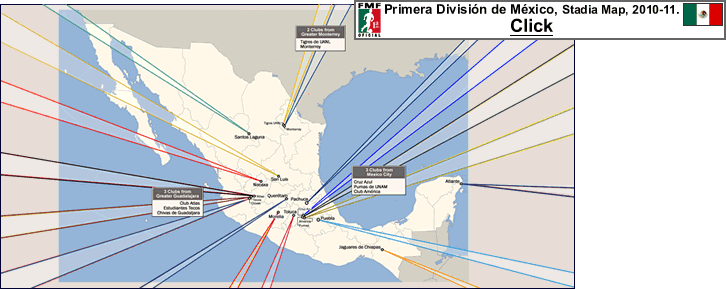
Primera División de México 2010-11 – Stadia map
…
Mexican Primera 2010 Apertura, Primer, by John Jagou at BigSoccer.com
…
Both Apertura (August to December) and Clausura (January to May) champions are decided by the 8-team playoffs called the Liguilla {see this}. One club is relegated each season, and that is determined by the lowest 3-season total points ratio (ie, just like Argentina’s cynical system). This basically makes it easy for established clubs to avoid a one-bad-season relegation, and makes it harder for just-promoted clubs to remain in the first division, because newly-promoted clubs usually have to finish closer to the middle of the table to avoid the drop, since their points ratio will be from just 34 games versus other clubs whose ratio will be determined from 68 or 102 games.
There are some changes to the format {which, if you are unfamiliar with the Mexican top flight, you can read about on the map page of my last map of the Primera División de México, here [Feb. 9, 2009]}…Copa Libertadores spots #s 2 and 3 are no longer being decided by the now-scrapped Inter-Liga competition, but by the second best and third best finishes in the Apertura general table (Apertura Classification stage), and as before, the Apertura Classification stage leader gets the #1 Copa Libertadores spot.
So when following the Primera Divisón de México, especially in the autumn months (ie the Apertura), it is wise to keep an eye on not just the three divisions, but also the combined 18-team general table, because coveted Copa Libertadores spots are being fought for there.
…
Clausura 2010 champions were Deportivo Toluca, who beat Santos Laguna on penalties in the final of the playoffs in May. This is Toluca’s 10th title, making them tied for second-best all-time with América. Chivas de Guadalajara have the most titles, with 11. {List of Mexican professional era champions, here}. That makes it three of the last ten championships won by Toluca…pretty impressive for a club like Toluca, which gets relatively little media attention, plays in a stadium that only holds 27,000, and are from a city that is sixth-largest in the country {List of metropolitan areas in Mexico by area, here}. The fact that some clubs are owned by giant conglomerates, and in the case of Club América, by Televisa (the largest Spanish-speaking television and media organization in the world) doesn’t help provincial clubs like Toluca. Televisa actually owns two teams (which is a cartel, and should be illegal, like most everywhere else): the very popular and successful América, and the very weakly-supported and trophy-less San Luis. There is big money in televising Primera Divisón de México games {see this article, from the Australia.to News site, from 18 May, 2010, by Emilio Godoy, ‘Football Fortunes for Mexican TV‘}. América are known as Millonetas (Millionaires), for all the money the club has at it’s disposal.
Just like in Argentina, two clubs get the lions’ share of the spotlight in Mexico…Club América and Chivas de Guadalajara (Mexico City clubs Cruz Azul and Pumas de UNAM are the only other clubs that have relatively large fan support). But nevertheless, just like in Argentina, other clubs keep on winning the recent tournaments. In Mexico’s case, recent champions were Toluca (Apertura 2005, Apertura 2008, and Clausura 2010 champions), CF Monterrey (Apertura 2009 champions), Pumas de UNAM (Clausura 2009 champions), Santos Laguna (Clausura 2008 champions), and Pachuca (Clausura 2006 and Clausura 2007 champions). América’s last title was in Clausura 2005; Chivas’ last title was in Apertura 2006. [The wide range of recent champions is most likely less a product of an even playing field and is more likely a result of the byzantine league/playoff system and split season structure, where an upset or two has much larger implications here than it would in a long-haul, 10-month season.]
Below is a chart that shows the results of a 2010 poll, {found here (Consulta.mx site)}. It shows the most popular fútbol clubs in Mexico, and the percentage changes from 2008 to 2010….

Chivas de Guadalajara is owned by the corporation that runs the Ponzi-sceme that is Ominlife (ie, stay away if you don’t want to be ripped off) (Omnilife is the main rival of Herbalife). Chivas de Guadalajara is a club that prides itself on only fielding players born in Mexico. [The policy is similar to the one at Spain's Athletic Bilbao, who only field Basque players, but there is a crucial difference... because the Spanish government suppresses Basque identity at an institutional level; while with respect to Chivas, it is excluding all others except the national archetype (ie, Mexicans).] Chivas de Guadalajara’s policy, in this day and age of open markets, more fluid borders, and more cross-cultural interchange, is racist by definition. It is also foolish, because the policy does not give the club a chance to attract the best players. Chivas would probably have had a better chance of winning the 2010 Copa Libertadores final versus Internacional of Brazil, had they not had their Mexicans-only policy. I mean, Chivas doesn’t even want Mexican-Americans on their squad {see this from The Offside.com, by Daryl, from Feb. 2008, ‘But is He Mexican Enough?‘}. That’s when xenophobia trumps logic, because a California-born Mexican is still Mexican ethnically, and was born in an area that was once part of the nation of Mexico. Anyway, it is something that many Mexicans feel proud of and I am sorry but those people should be re-considering what it means to be a citizen of the planet Earth in 2010…people should be tearing down walls between different societies – legal walls, metaphorical walls, and physical walls. People should not be proud of policies of exclusion that prevent the inclusion of others who are different. And yes, I know in America there are many on the right wing who advocate just the sorts of things my last few sentances decried, like building a wall at the Mexican border, or passing creepy document-check/racial profiling laws like they did in the state of Arizona. But I do not support that political platform, I support an inclusive policy which is the polar opposite. Think of it this way…what would the response be if a German football club had a policy of only playing Germans? You think people would stand for that? OK, let’s try it with a country with a more benign 20th century history…what if a Swedish club had a policy of only playing Swedes? You see…no matter how you frame it, it comes off as racist, because IT IS RACIST. So why does Chivas de Guadalajara get a pass on this? For crying out loud, the Primera División de Mexico has exactly zero African players in it {see this, from The Best Eleven site, ‘Foreign Players in the Primera Divisón de México‘ [Feb., 2009]}. I checked, and as of October, 2010, there still are not any players from Africa in the rosters of any club in the Primera División de México. Granted, there have been a few Afro-Mexican players, including current Cruz Azul DF Melvin “Melvin of the Cocoa Crispies” Brown, and there have been a couple of Afro-Mexicans who have played for the Mexico national team, including Tottenham’s Giovanni dos Santos {see this, from The Culture of Soccer site, ‘Soccer and the Afro-Mexican Population‘ [March 12, 2007]. Also, it should be pointed out that there are a few prominent, dark-skinned Latin American players in the league, such as Tigres de UANL captain and FW Itamar Batista da Silva {profile at e.wikipedia.org, here}. But I did not make up that nickname that has been foisted upon Melvin Brown, and it pretty much proves my point about the damaging effects that the institutional encouragement of racial exclusivity has on a culture. Because it is pretty hard to accept the fact that that sort of nickname is still tolerated in Mexico.
And don’t get me started on Chivas de Guadalajara’s new stadium. Sure Estadio Omnilife {skyscrapercity.com thread, here} looks impressive and unique. It has been described as looking like a flying saucer landing on a volcano. But didn’t management consider the colossal irony of the fact that the exterior of the stadium is clad in actual, real, live grass, but the playing surface is artificial turf ? Real grass on the outside for show, but inside, where it matters, on the field, the players must run and tackle and slide and fall, and risk injury, on a playing surface that is concrete covered with plastic bristles. Duh. Estadio Omnilife is the sort of thing you would expect to see being built by Mr. Burns during an episode of The Simpsons.
-
I decided to make this map a Stadia map, even though I was pretty sure I wouldn’t be able to find good quality photos of some of the stadiums, so sorry for that. I decided to “make up” for that by adding another photo for each stadium, an interior shot. I decided I had to do that when I saw photos of Santos Laguna’s new Estadio Corona… it looks like a nice place to watch a match {photo gallery of Estadio Corona (II) with lots of photos of of the swank new facilities, here (at ‘Disfruta la Galería de Inaguación’, which is below the time-lapse video}. Plus I wanted to better show Deportivo Toluca’s ground, one of the oldest stadiums in Mexico (opened in 1954; hosted games in both World Cups in Mexico in 1970 and 1986), which I think is one of the coolest-looking football stadiums around. Here is an 11-photo gallery of Toluca’s Estadio Nemesio Díez, from deportivotolucafc.com, {click here}.
Thanks to the contributors to the pages at en.wikipedia.org, Primera División de México
Thanks to FootieMap.com/Mexico for location help.
Thanks to Ludwig for his message, which included maps he made of the Mexican first and second divisions, here (in the Comments section at the bottom, comment #4).
Photo credits…
Santos Laguna – exterior shot: at imageshack.us , here
interior: at Territorio Santos Modelo.com.mx .
San Luis – exterior: Google Earth shot via The Mistic.wordpress.com , here.
interior: BigSoccer.com forum (with lots of Mexican stadium photos), here.
Tigres de UANL – exterior: Fermin Tellez Rdz at Flickriver.com , ‘Estadio Universitario, San Nicholás de los Garza, N.L. México‘. Fermin Tellez Rdz’s photostream at Flick.com
interior: unattributed, from nuevaleon.wordpress.com [from Flickr.com files].
Monterrey – exterior: http://www.football-pictures.net
interior [wide photo]: Pato Garza at commons.wikimedia.org.: ‘The Monterrey Institute of Technology and Higher Education’s Tecnológico Stadium in Monterrey, Mexico, during a professional football (soccer) match‘.
Necaxa – exterior: [sitio oficial] necaxafutbol.com/Estadio
interior: {from crisolplural.com/Deportes/Futbol} , Estadio Victoria de Aguascalientes.
Atlas – exterior: lalomg_0326 at flickr.com.
interior: Maximilian Laackmaan at www.asseltours.de, via www.fussballtempel.com.
Estudiantes Tecos – exterior:’Remodelan el estadio Tres de Marzo‘ (www.diacritico.com from 5-22-2009).
interior: Rigoberto H. Esquivel at mediotempo.com, here.
Chivas de Guadalajara – exterior: mexico.cnn.com, 29 de Julioo, 2010, ‘El Estadio Omnilife tendrá una inauguración al estilo europeo‘.
interior: Marco Guzman, Jr. at en.wikipedia.org/Estadio Omnilife, here.
Queretaro – exterior: www.queretaro.travel at flickriver.com.
interior: www.futboldeseleccion.com/Estadios Mexico .
Deportivo Toluca – exterior: Sergiopons at Panoramio.com, ‘Estadio Nemesio Diez desde el aire‘ .
interior: www.deportivotolucafc.com/estadio
Morelia – exterior: pollomar at photobucket.com
interior: ‘Monarchs will play Sundays noon during A10‘ (www.mediotempo.com, 5-26-2010).
Pachuca – exterior: ‘Inicia el cuadrangular Pachuca Cuna del Futbol Mexicano‘.
interior: Hector Jesus Tapia Fernandez at en.wikipedia.org/Estadio Hidalgo
Cruz Azul – exterior: Estadio Azul by vedur77 at flickr.comskyscrapercity.com thread, Estadio Azul (6 photos).
interior:estadio Azul by originalrocker at flickr.com. originalrocker’s photostream at flickr.com.
Pumas – exterior: unattributed/bigsoccer.com/forum.
interior: www.dalepumas.com/Estadio Olimpico Universitario.
América – exterior: unattributed at photobucket, but it says Ricardo Garrido/esmexico.com…no luck finding a link.
interior: Estadio Azteca by Samuel G. Valdes Montemayor at www.mexicofotos.com, here.
Atlante – exterior: www.colchonero.com/Futbol Mexicano thread [note: this link is recommended if you would like to see Mexican top flight jerseys circa 2009].
interior: fricki.net thread, here.
Puebla – exterior: [oficial sitio] www.pueblafutbolclub.com.mx/Estadio.
interior: unattributed at imageshack.us.
Jaguares de Chiapas – exterior: Miguel Abarca at mediotiempo.com
interior: danorebel at photobucket.com
